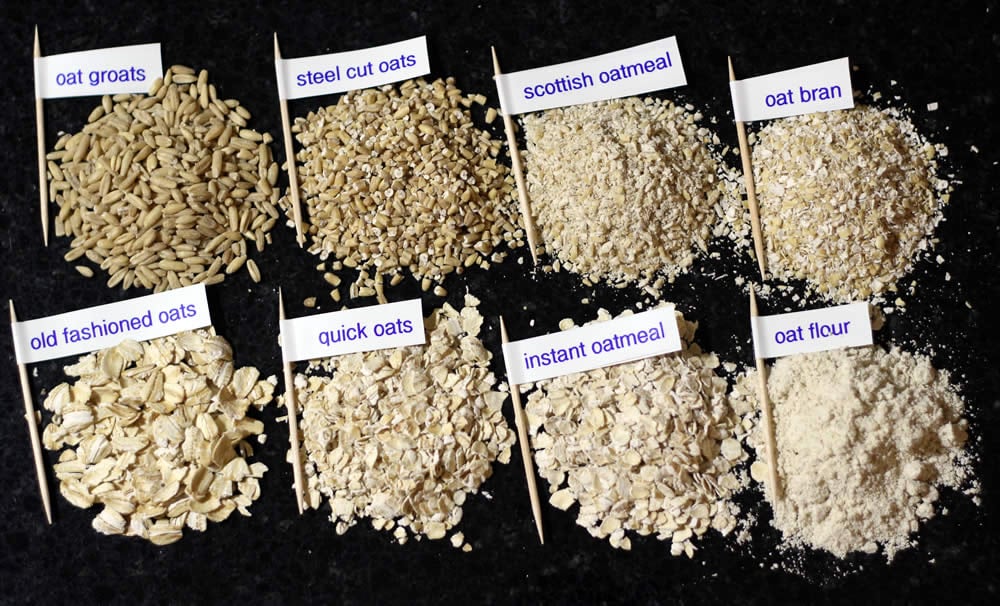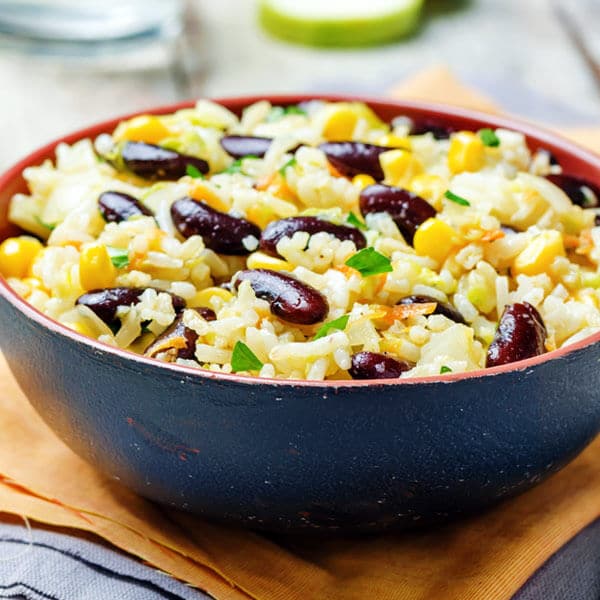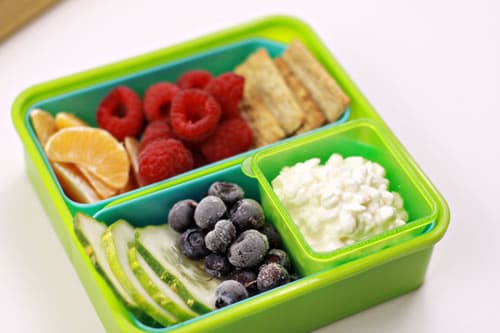The Types of Oatmeal
Oct 05, 2012, Updated Oct 14, 2017
Groats. It’s a funny word. Could be a grumpy goat or a healthy whole grain. Since this post is part of October Unprocessed and I’m a nutrition nerd, odds are it’s the latter. (Actually, I’m also an animal-loving nerd, so really, it’s a crap shoot.)
I’m sure you’ve heard that you should eat less processed foods. Heck, as a dietitian, I’ve been doling out that advice for ten years. But, it’s kind of a confusing concept. At the most basic level, any change intentionally made to a food before it winds up on our taste buds counts as processing. It can range from dehydrating fruits to hydrogenating fats and the different types of processing can be straightforward or complex. Unless you’re living sustainably and exclusively from your own grain field, vegetable garden, and fruit trees, the truth is that you’re probably consuming processed foods. Join the club.
What does processing really look like? Let’s take oats as a case in point. If you’re a visual learner, please consider the photo at the top of this post. See if you can tell the difference between the many piles of oaty goodness. (I’ll explain more about the piles in a minute…)
One of the most memorable quotes from the movie Super Size Me is this: “It is a matter of common knowledge that any processing that foods undergo serves to make them more harmful than unprocessed foods.” As a general rule, the more we mess with it, the worse it is for us. So why do we do it? Reasons for processing can be to improve taste, shorten preparation time, or increase shelf life, so it’s not all done with bad intentions.
Oats are a perfect example of a food available in the marketplace that’s gone through varying levels of mechanical processing. They’re also a picture-perfect example of a healthy food, as their heartiness seems to be especially satiating in our bellies and their fiber seems to lower cholesterol in our blood. (In a country where the two-thirds of us are overweight and the leading cause of death is heart disease, that’s no small feat.)
One of the most common reasons oats and other foods are processed in the first place is to reduce cooking time. Oat groats take 60 minutes to cook while instant oatmeal is ready in 60 seconds. Nutritionally speaking, all the options pictured are considered whole grains, but the closer you get to the groat end of the spectrum, the better (good advice for all areas of life, I think). If you’re not ready to dedicate an hour to your breakfast cereal, aim for the other oat options that are minimally processed. We use the brown rice setting on our rice cooker to make groats in the evening (while we watch Mythbusters or Wipeout or something else educational), and we’ve a got healthy breakfast for the whole week that can be reheated in the same time it takes to make the instant stuff. Check out my recipes for Cherry Maple Granola or Coconut Mango Barley Breakfast (just substitute cooked oat groats for the barley in this one) if you want to get a little grainy this month.
Here are the types of oats shown in the picture above:
Oat groats: as whole grainy as you can get where oats are concerned. Unadulterated. Only the inedible hull has been removed. Cooks in 50-60 minutes.
Steel cut oats: also called Irish oats or pinhead oats, these are just groats that have been cut into smaller pieces to speed cooking. Cook in 10-20 minutes.
Scottish oatmeal: another version of groats that have been broken into bits, only these are stone ground instead of being cut. Cooks in 10 minutes.
Oat bran: a high-fiber part of the oat that’s been removed and can be eaten separately. Oat bran can be prepared as its own hot cereal or simply sprinkled on your favorite bowl of breakfast to boost the nutrient content of every bite. Cooks in 2 minutes.
Old fashioned oats: groats that are steamed and then pressed flat. Increasing the surface area this way and partially cooking them helps you get breakfast to your mouth faster. Cooks in 5 minutes.
Quick oats: like old-fashioned oats, except rolled thinner and steamed longer. Cook in 1 minute.
Instant oatmeal: like quick oats, except rolled even thinner and steamed even longer. Cooks in 1 minute. (This is the only product on this list that has been processed in an additional way – it’s had stuff added to it before packaging. In the case of the “original” or plain flavor, pictured here, salt, color, vitamins and minerals have been mixed with the oat flakes. The popular flavored packets have all that, plus added sugar, which bumps up the calories.)
Oat flour: pulverized groats that can be used in baking, etc. This is still considered a whole grain because nothing was removed before the oats were ground into flour.
Remember, it’s all relative. It doesn’t have to be all whole grains all the time. If you’re currently eating quick oats, go one step to the left on the spectrum for October Unprocessed. Chances are you’ll be amazed and delighted by the change in texture and you’ll have yourself a new favorite breakfast. And if you go all the way to the groats, you’ll have a new favorite word.





















I never even thought about using a rice cooker. I have one that my dad gave to me. I may try using that for steel-cut oats, which I LOVE, and they’re easier to find in the stores that groats. Thank you for the information!
Hi Jessica Marie. Thanks for taking the time to let us know your strategy. You bring up a good point: price. That’s another layer to consider when picking your breakfast oats.
I change up between old fashioned oats and steel cut oats depending on my budget. I have a slow-cooker recipe that I use for my steel cut oats.
I bought steel cut oats for the October challenge and love them. The texture is wonderful and I’m satisfied until lunch when I have them for breakfast. Good stuff!
Hi Jonie. Well, you’re not alone. When they study breakfast foods to see which ones keep people full the longest, oats nearly always win.
I use bob’s red mill rolled oats, where do they fit in on this list?
I took a peek at Bob’s products called “rolled oats”. It looks like there are several types – instant rolled oats, quick cooking rolled oats and old fashioned rolled oats. They’re definitely the kind that have been steamed and pressed flat. So, depending on which one you have and how long the recommended cooking time is, you’re probably about half-way or two-thirds of the way down the list.
I had to check blood sugars post meals with my last pregnancy. Steel cut was ok for my sugar, anything more processes spiked it significantly. FYI for readers concerned with sugar/insulin response.
That’s very interesting. We always tell patients that blood sugar response can be an individual thing. If you have a way to track it, like with a blood sugar monitor, you can really see how your body responds to different carbohydrate sources.
I just bring a pot of oat groats, water, and sea salt to a boil in the evening. Cover, turn off the stove, and let them sit overnight. They usually only need 5-10 minutes in the morning. Thanks for the post! Groats are great for other meals, too.
The bag I have says “Large Flake 100% rolled whole grain oats” and they look like the old fashioned oats in the above photo, but the coooking time is considerably longer at 14-16 minutes.
Hmmm…I haven’t come across those. Just a guess, but I wonder if they take longer to cook because of the larger sized flake? I’ll have to keep my eye out for them at the store.
Thanks for your comment, Annie. 8 minutes is pretty reasonable, considering you’re still getting a whole grain for breakfast.
Steel cut oats taste so much better than old-fashioned or rolled oats. They are delicious. I’ve gotten so accustomed to steel cut that old-fashioned oats basically taste like paper to me, and I think the instant stuff is inedible.
Bob’s Red Mill does quick cooking steel cut oats which are broken down into even smaller pieces — they cook in about 8 minutes or so.